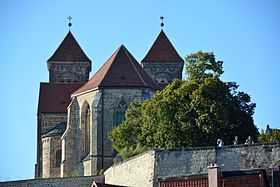Quedlinburg Abbey
| Imperial Abbey of Quedlinburg | ||||||||||
| Reichsstift Quedlinburg | ||||||||||
| Imperial Abbey of the Holy Roman Empire | ||||||||||
|
||||||||||
|
Castle and abbey of Quedlinburg
|
||||||||||
| Capital | Quedlinburg | |||||||||
| Government | Elective principality | |||||||||
| Historical era | Middle Ages, Early modern | |||||||||
| • | Abbey founded | 936 | ||||||||
| • | Upper Saxon Circle | 1500 | ||||||||
| • | Turned Protestant | 1539 | ||||||||
| • | Secularised to Prussia | 1802/3 | ||||||||
| • | Incorporated into Province of Saxony |
1816 |
||||||||
|
||||||||||
| Today part of |
|
|||||||||
| St. Servatius | |
|---|---|
| Collegiate Church of St. Servatius | |
| Stiftskirche St. Servatii Quedlinburg | |
 |
|
| Location | Quedlinburg |
| Country | Germany |
| Denomination | Lutheran |
| Website | Website of the congregation |
| History | |
| Founded | 1070 (current building) |
| Founder(s) |
Otto I Queen Mathilda |
| Consecrated | 1129 (current building) |
| Architecture | |
| Heritage designation | UNESCO World Heritage Site |
| Style | Romanesque |
| Type | Cultural |
| Criteria | iv |
| Designated | 1994(18th session) |
| Reference no. | 535 |
| State Party | Germany |
| Region | Europe and North America |
Quedlinburg Abbey (German: Stift Quedlinburg or Reichsstift Quedlinburg) was a house of secular canonesses (Frauenstift) in Quedlinburg, Saxony-Anhalt, Germany. It was founded in 936 on the initiative of Saint Mathilda, the widow of King Henry the Fowler, as his memorial. For many centuries it and its abbesses enjoyed great prestige and influence.
Quedlinburg Abbey was an Imperial Estate and one of the approximately forty self-ruling Imperial Abbeys of the Holy Roman Empire. It was disestablished in 1802/3.
Today, the mostly Romanesque buildings are a World Heritage Site of UNESCO. The church, known as Stiftskirche St. Servatius, is used by the Lutheran Evangelical Church in Germany.
Quedlinburg Abbey was founded on the castle hill of Quedlinburg in the present Saxony-Anhalt in 936 by King Otto I, at the request of his mother Queen Mathilda, later canonised as Saint Mathilda, in honour of her late husband, Otto's father, King Henry the Fowler, and as his memorial. Henry was buried here, as was Mathilda herself.
...
Wikipedia



